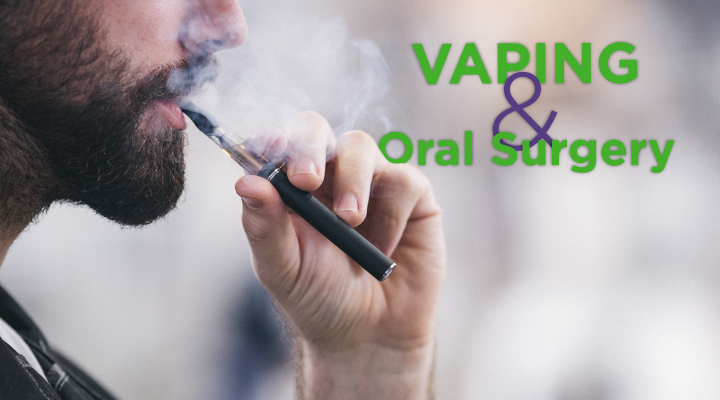Preparing for oral surgery? It’s critical to a smooth recovery that your dentist is aware of your habits and lifestyle. Tobacco use, vapes and e-cigarettes can make recovery and healing after dental surgery more difficult. Some think e-cigarettes are a safer alternative to smoking cigarettes, but research suggests they could be even worse for our oral health than traditional cigarettes. In combination with dental surgery, e-cigarette and vape usage can be extremely harmful. Understand the risks and discuss with your dentist how to prepare for oral surgery as a smoker.
Ingredients Harmful to Your Oral and Overall Health
- Nicotine is a major component of tobacco. It reduces the amount of oxygen that our vital organs and tissues receive. This makes the healing process and the surgery itself more dangerous. When oxygen isn’t circulating properly, it can increase your risk of developing an infection. Additionally, when you smoke after having dental surgery, the action of drawing from the vape to inhale “can pull the clot from the extraction site and cause dry socket.” This is a very painful experience. Nicotine can also make it harder for our bodies to repair. Not only does it damage the tissue in the mouth, but it also prevents wounds from healing like they normally would. The American Association of Nurse Anesthetists writes that vaping is no better than smoking when it comes to dental surgery. It increases the risks associated with anesthesia and can lead to other complications for surgery patients. If you have any questions about dental surgery, we highly recommend you discuss with your dentist and doctor.
- “Propylene glycol” is the ingredient in vapes or e-cigarettes that carries the nicotine from the vape into the mouth. When inhaled, this ingredient breaks down into different acidic substances. These substances are very harmful to our teeth, and toxic to enamel and soft tissue.
- Vegetable glycerin is used in medicine, personal care and the food industry, and it’s also found in e-cigarettes and vaporizers. It’s mixed with flavorings when used in e-cigarettes and often called “e-liquid”. Studies show that the combination of these two substances makes bad bacteria four times as likely to stick to our enamel. The same study states that enamel hardness was weakened by 27% when we use flavored e-cigarettes versus unflavored. This substance allows more cavity-causing bacteria to stick to the teeth. Plus, these teeth are already softer from e-cigarettes use. This promotes and continues rampant tooth decay.
These are simply the substances in e-cigarettes and vaporizers that can harm your dental health. The lithium batteries also add a great amount of risk, as they can overheat and explode. A study released in 2018 “uncovered 2,035 visits to U.S. emergency rooms from 2015 to 2017 for e-cigarette burns and explosion-related injuries.”
Quitting is the Ultimate Goal
In 2017, 44 percent of individuals surveyed did not think e-cigarettes were harmful. Awareness around the negative oral and overall health impacts of vaping has been rising, but more is needed. Vaping and e-cigarettes cause long-term problems for the mouth. Smoking makes you three times as likely to develop periodontal (gum) disease, and the nicotine in e-cigarettes and traditional cigarettes also causes the breakdown of tissue in the mouth.
Being aware of the risks vapes and e-cigarettes pose to dental surgery is only half the battle. Don’t be afraid to communicate with your dentist and health care provider about your use of tobacco or e-cigarettes. Your dentist is more concerned about your safety during oral surgery than anything else.
Quitting smoking is the ultimate goal, and e-cigarettes may be one tool to help accomplish this. However, you should not allow one bad habit to replace another. The nicotine and other ingredients in e-cigarettes and vaporizers are just as bad, if not more so, than cigarettes to your oral and overall health.
For more information and help to quit vaping or smoking, call The American Cancer Society at 1-800-227-2345, or if you’re looking for a dentist in your area, click here.

